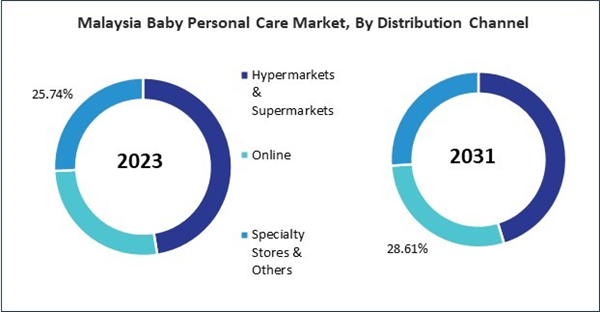Supermarkets and hypermarkets play a crucial role in the distribution of these products, serving as key touchpoints for parents and caregivers seeking convenience, variety, and affordability. These retail giants offer a wide selection of baby care items under one roof, providing customers with one-stop shopping experience. Therefore, the demand for baby personal care from Supermarkets and hypermarkets was 989.0 million units 2023 in the Indian Market.
The China market dominated the Asia Pacific Baby Personal Care Market by Country in 2023, and would continue to be a dominant market till 2031; thereby, achieving a market value of $18,343.1 Million by 2031. The Japan market is registering a CAGR of 5.8% during (2024 - 2031). Additionally, The India market would showcase a CAGR of 7.2% during (2024 - 2031).
In developed countries with higher disposable income levels and access to healthcare, baby personal care products are widely adopted. Parents in these regions prioritize their infants’ health, hygiene, and overall well-being, leading to high adoption of diapers, wipes, bath products, skincare items, and oral care products. The availability of a wide range of such products in supermarkets, pharmacies, specialty baby stores, and online retailers further contributes to their adoption.
Many emerging nations have a growing middle class with rising purchasing power. Nevertheless, many population sectors may not have easy access to baby care items due to infrastructure deficiencies or other financial constraints. However, as living standards improve and urbanization rates rise, a gradual shift towards using specialized baby care products is driven by increased awareness of hygiene and healthcare practices.
Increasing birth rates result in a larger population of infants and young children, which is expanding Australia’s potential consumer base for such products. The rise in the number of babies born yearly translates into higher demand for essential baby care items such as diapers, wipes, bath products, skincare, and feeding accessories, driving market growth and sales volumes. Hence, the growing number of childbirths and rising disposable income in the region drive the market’s growth.
Based on Product, the market is segmented into Toiletries, Cosmetics, and Others. Based on Distribution Channel, the market is segmented into Hypermarkets & Supermarkets, Online, and Specialty Stores & Others. Based on countries, the market is segmented into China, Japan, India, South Korea, Australia, Malaysia, and Rest of Asia Pacific.
List of Key Companies Profiled
- L'Oreal S.A.
- Dabur India Ltd.
- Abbott Laboratories
- Unilever PLC
- The Procter & Gamble Company
- Kimberly-Clark Corporation
- Johnson & Johnson
- Beiersdorf AG
- Himalaya Wellness Company (Himalaya Global Holdings Ltd.)
- Avon Products, Inc. (Natura &Co Holding S.A.)
Market Report Segmentation
By Product (Volume, Million Units, USD Billion, 2020-2031)- Toiletries
- Cosmetics
- Others
- Hypermarkets & Supermarkets
- Online
- Specialty Stores & Others
- China
- Japan
- India
- South Korea
- Australia
- Malaysia
- Rest of Asia Pacific
Table of Contents
Companies Mentioned
- L'Oreal S.A.
- Dabur India Ltd.
- Abbott Laboratories
- Unilever PLC
- The Procter & Gamble Company
- Kimberly-Clark Corporation
- Johnson & Johnson
- Beiersdorf AG
- Himalaya Wellness Company (Himalaya Global Holdings Ltd.)
- Avon Products, Inc. (Natura &Co Holding S.A.)
Methodology

LOADING...









